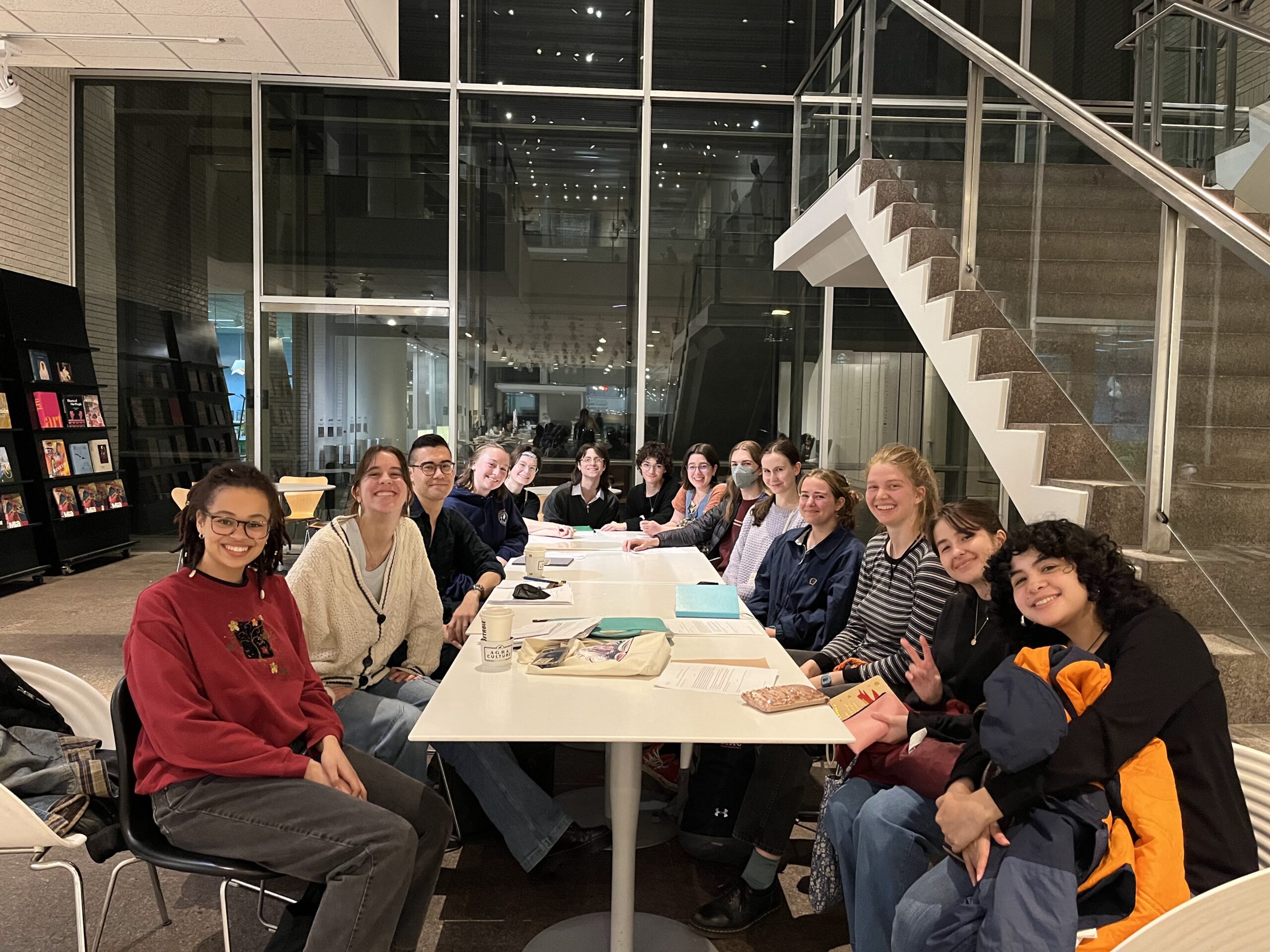Classes in the Cities
Contact
The Words: Macalester's English Student NewsletterSenior Newsletter Editors:
Birdie Keller '25
Callisto Martinez '26
Jizelle Villegas '26
Associate Newsletter Editors:
Ahlaam Abdulwali '25
Sarah Tachau '27
by Ahlaam Abdulwali ’25

Macalester’s location in the heart of the Twin Cities area is one of the many draws of attending the college. As a student, it may be difficult to explore the Twin Cities during the semester because of our course loads. The English department, however, encourages engagement with the vivacious art scene of Minneapolis/St. Paul by sponsoring field trips for English courses. This article includes the perspectives of both a student (myself) and Professor Penelope Geng in regard to these field trips. Thank you to Professor Prior for hosting my course’s trip and to Professor Geng for their contributions to this article!
A Student’s Perspective:
In my ENGL 280 Crafts of Writing: Poetry – Forms of Attention, Attention to Form course, Professor Michael Prior hosted a class at the Minneapolis Institute of Art (MIA) instead of our usual Old Main 001 classroom. I carpooled there with 3 of my classmates for a short 20-minute drive, and we met the rest of our class in the lobby of the museum. There, we discussed two ekphrastic poems we read in preparation for class. Ekphrastic poems, like W.H. Auden’s Musee Des Beaux Arts, transform and translate the emotional experience of a visual art form into a literary art form.
Our task at the MIA was to wander the museum for twenty minutes until we found a piece that ignited something within us. As an incredibly indecisive person, this was more of a challenge than I anticipated. I knew that I wanted to write about a painting, and more specifically one that was not a religious work, but that did little to nothing in regards to narrowing down my choices. I took a picture of each painting that I felt drawn towards, with the idea that I could always go back if I did not find something that I deeply connected with.
That was until I reached the colossal 161 1/2 × 88 1/2 inch oil painting titled Cleopatra. This late 17th-century piece by Julis Kronberg, a Swedish artist well-known for his large vertical paintings, features three subjects, the center one being Cleopatra, and depicts an interpretation of Cleopatra’s death. For around 30 minutes, I stood there and wrote everything I possibly could about that piece. The notes I took ended up spanning two pages in my journal, and I never put my pen down for more than 10 seconds. Professor Michael Prior gave us a rendezvous point and time, and once there, we discussed our observations and pieces that we chose to write about. From these observations, we each wrote an ekphrastic poem about our pierce of choice. My ekphrastic poem is a sonnet crown and each sonnet focuses on one of the subjects in the painting. The experience of seeing the actual painting in person, in all its glory, enabled me to connect with painting beyond the surface level.
A Professor’s Perspective:
In this section, I asked Professor Geng about their experience taking one of their classes out into the cities. She wrote about her experience below!
I took students in my ENGL 115 Shakespeare class to see a new production of Shakespeare’s Twelfth Night. The theater is Ten Thousand Things (read about them here). They’re one of my favorite theaters in the Twin Cities. I’ve taken students to see their previous shows (pre-pandemic) and I have always been impressed by their actors (some of the best in the TC), their inventiveness with staging, and their engagement with audiences. I appreciate their mission: to bring theater to all audiences, including (as they say on their website) “shelters for the unhoused, correctional facilities, low-income senior centers, after-school programs, women’s shelters, and locations in greater/rural Minnesota.” The performance that my class attended was for paying audiences. The venue was the second floor gallery Hennepin Avenue United Methodist Church. The actors performed in the center of the gallery; audiences surrounded the square playing space on all four sides. Behind audiences were paintings from the Renaissance and the 19th century–all depicting important stories from the Bible.
Twelfth Night is known as a “festive comedy”–it’s filled with music, foolery, and mistaken identities. This interpretation, by a wildly talented and diverse cast, brought the text’s ribald humor to life. Not only were the audiences entertained, but the actors too! Between scenes, the actors were cracking up at their fellow actors’ antics. It feels cathartic to enjoy a good laugh with other people.
My students said they really enjoyed the field trip. For some, it was their time seeing a live performance of Shakespeare and by a professional company. A number of them found it enriching to see the play after spending a week and half studying it as a reading text.
Finally, I want to give a shout out to the English department (specifically Critchett Fund Committee) for making this field trip possible and to our ever wonderful Jan Beebe for coordinating the purchasing of the group tickets.
———————————————————————————————————————————————-
Prior to my trip to the MIA, I never thought to write poetry that communicates with the emotional experience of viewing art. I always appreciate the opportunity to get out of my comfort zone and get out into the city, and this trip was a wonderful reminder of just how rich the arts scene is in the Twin Cities. The two classes mentioned above, ENGL 280 and ENGL 115, are not the only classes that engage with the Twin Cities Arts scene. Professor Daylanne English took her ENGL 274 African American Literature course last semester to the Guthrie Theater to see Pearl Cleage’s play titled Blues for an Alabama Sky. There are also several courses next semester that have trips planned in their syllabi. Thanks again to Professor Geng and Professor Prior for hosting these trips!